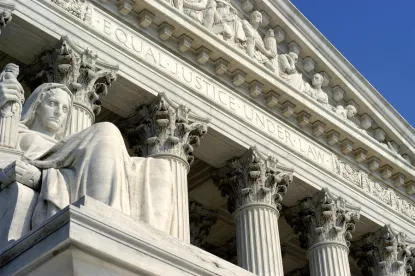Greetings, Court Fans!
Even though the Court is in the midst of a historically slow term (as measured by opinion output), we've managed to fall behind. We'll take advantage of this off-week to get you caught up to speed with summaries of three outstanding (as in, overdue, if not necessarily superlative) decisions.
First up, in Encino Motorcars v. Navarro (No. 16-1362), the Court finally resolved whether automobile service advisors are "salesmen" for purposes of a provision of the Fair Labor Standards Act exempting from overtime requirements "any salesman, partsman, or mechanic primarily engaged in selling or servicing automobiles." Faithful readers will recall that the Court punted this question just two terms ago, when it vacated a Ninth Circuit decision that accorded Chevron deference to the Department of Labor's determination that service advisors fall outside the exemption. Because that 2011 determination was an abrupt and unexplained about-face from the DOL's longstanding position that service advisors are exempted, the Court held (7-2) that Chevron deference was not appropriate. Justices Thomas, joined by Alito, would have gone further and held that service advisors plainly are covered by the overtime exemption.
He got his way on the return trip, after the Ninth Circuit ruled on remand that service advisors are not exempt. Now writing for a 5-4 majority, Justice Thomas reasoned that, although service advisors don't sell cars, they do sell services, and therefore fall within the ordinary meaning of the term "salesman." And, though they don't "service" vehicles by tinkering under the hood, they are "integral to the servicing process" and therefore are "primarily engaged in . . . servicing automobiles." Therefore, Thomas concluded, "[u]nder the best reading of the text, service advisors are ‘salesm[e]n,' and they are ‘primarily engaged in . . . servicing automobiles." So no overtime!
Writing for the left side of the Court, Justice Ginsburg issued a pretty straightforward rejoinder. She began and ended with the simple observation that service advisors "neither sell automobiles, nor service (i.e., repair or maintain) vehicles." Therefore, they're not primarily engaged in selling or servicing automobiles as required to fall within the exemption.
The difference in these two equally simple readings of the exemption is that the majority distributed the disjunctive "or" throughout the text (holding that the exemption applies to anyone who sells automobiles or automobile services who is primarily engaged in automobile sales or servicing), while the dissent read the exemption to apply only to salesmen who are primarily engaged in the sale of automobiles or partsmen and mechanics who are primarily engaged in servicing automobiles. Justice Ginsburg justified her narrower reading in part by reference to the longstanding (if infrequently employed) canon that FLSA exemptions should be narrowly construed to achieve the Act's remedial purposes. In perhaps the most consequential part of the majority's opinion, Justice Thomas rejected this canon entirely. "The narrow construction principle relies on the flawed premise that the FLSA pursues its remedial purpose at all costs." But, Justice Thomas maintained, the FLSA's overtime requirement contains so many exemptions that they "are as much a part of the FLSA's purpose as the overtime-pay requirement" itself. Therefore, in the majority's view, there was no reason to narrowly construe the exemption. Because service advisors sell service, they're salesmen who are primarily engaged in the servicing (not sale) of vehicles. That aspect of the Court's holding in Encino holding may have repercussions that echo beyond the nation's car dealerships…
Although Encino split the Court 5-4, the 7-2 division in Kisela v. Hughes (No. 17-467) was far more impassioned. In what has become a common occurrence, the Court summarily reversed a Ninth Circuit decision denying qualified immunity to a police officer and complaining that it has "repeatedly told courts—and the Ninth Circuit in particular"—that they are misapplying the qualified immunity standard. And in what may become a common occurrence, Justice Sotomayor responded with a fiery dissent castigating the Court for sanctioning a "shoot first and think later" approach to law enforcement.
At issue was respondent Amy Hughes's § 1983 action alleging that petitioner Andrew Kisela, a police officer in Tucson, Arizona, violated the Fourth Amendment when he shot her four times, causing her serious injuries. Under Hughes's version of the facts (credited at summary judgment), Kisela responded to a report that a woman matching Hughes's description was wielding a knife and acting erratically, but arrived to find that Hughes was calmly standing in her front yard and holding a kitchen knife in a nonthreatening posture several feet away from the only other person nearby, her roommate, who did not appear fearful. Kisela, accompanied by two other officers and separated from Hughes by a chain-link fence, shouted twice at Hughes to drop the knife and then shot her through the fence less than a minute after arriving at the scene. Given these facts, the Ninth Circuit held that Kisela should not be entitled to qualified immunity.
In reversing, the Court skipped to the second prong of the qualified-immunity analysis, which asks whether an officer's conduct violated clearly established law. The Court observed that the "border between excessive and acceptable force" is "hazy," making it especially inappropriate in excessive-force cases for a court to "define clearly established law at a high level of generality." Criticizing the Ninth Circuit's analysis of the circuit's own excessive-force case law, the Court found it "far from . . . obvious" under clearly established law that an officer in Kisela's position should have known that shooting Hughes would violate the Fourth Amendment, given his belief that Hughes posed an immediate threat to her roommate and did not respond to commands to drop the knife.
Justice Sotomayor, joined by Justice Ginsburg, dissented in an opinion that did not mince words. Reproaching her colleagues for failing to construe the record in Hughes's favor at summary judgment, Justice Sotomayor underscored the facts that showed Kisela's actions to be unreasonable: Hughes had not committed or been suspected of committing a crime and was not fleeing; she was holding the kitchen knife, a common household item, in a nonthreatening posture; she and her roommate both appeared calm; Kisela hastily fired without giving advance warning and without waiting to ensure that Hughes had heard and registered the command to drop the knife; and Kisela could have used lesser force such as a Taser. More broadly, Justice Sotomayor criticized the majority for yet again defining clearly established law in such narrow terms that qualified immunity essentially became "an absolute shield." She also noted the "disturbing trend" of the Court's "one-sided" use of summary reversals to award officers qualified immunity in difficult, fact-intensive cases that should be decided by juries, effectively signaling to officers that "they can shoot first and think later" and "tell[ing] the public that palpably unreasonable conduct will go unpunished."
And now, at last, we reveal the winner in the case of Hall v. Hall (No. 16-1150). It was . . . anyone who appreciates consistency in civil procedure. Three terms ago, in Gelboim v. Bank of America Corp., the Court held that when an order disposes of an individual case that has been consolidated with other cases for the purposes of multidistrict litigation, that order is immediately appealable, regardless of whether the other cases remain pending. But Gelboim didn't decide whether the same is true for cases consolidated under regular old Federal Rule of Civil Procedure 42(a). Hall did decide that question, unanimously: Of course it is.
That's really all you need to know (and you do need to know it), but since the case involved some family drama, we'll flesh it out a bit for you. Elsa Hall and Samuel Hall are siblings. Their mother, Ethlyn, lived in the Virgin Islands, as did Samuel (a lawyer), who served as her caretaker and managed her property. But Elsa allegedly turned Ethlyn against Samuel: Following Elsa's visit to the Virgin Islands, Ethlyn transferred all her property into a trust (with Ethlyn as trustee), moved to Miami with Elsa, and sued Samuel for mismanaging the property. Ethlyn then died, and Elsa (conveniently named successor trustee) stepped into her shoes. Samuel tried to countersue Elsa for turning their mother against him, but because Elsa was not a plaintiff in her individual capacity, he had to do so by filing a separate individual suit against her. On his motion, the district court consolidated the two cases under Rule 42(a). In a unified trial, the jury found for Samuel on his individual claims, awarding $2,000,000 in compensatory and punitive damages, but the district court granted Elsa a new trial, keeping that judgment open. The same jury also found for Samuel on Elsa's claims as trustee, resulting in the dismissal of those claims. Elsa tried to appeal, but the Third Circuit, on Samuel's motion, dismissed the appeal, concluding that consolidation rendered the two cases one so any appeal was premature until there was a final judgment on all claims.
The Supreme Court reversed, in a unanimous opinion by the Chief. Everyone agreed that if the district court had never consolidated the two cases, Elsa could now appeal the district court's judgment on the merits of the trust's claims. On the other hand, if Elsa's claims were treated as just one party's claims in a single suit (e.g., counterclaims), everyone agreed that an appeal of the dismissal of that partial set of claims would be premature. The case thus turned on a metaphysical question: When two cases are consolidated, do they become one case, meaning that no part is final and appealable until the whole is? Or do they remain separate cases, temporarily merged together only for convenience, and separately appealable when one of the constituent cases is finally resolved?
Neither the text of Rule 42(a) nor the plain meaning of the word "consolidate" provide enough guidance to answer this question. So the Chief turned to history. Specifically, in 1813—125 years before the Federal Rules of Civil Procedure came into existence—Congress enacted a statute, referred to as §823(a), which gave federal courts the power to "consolidate" causes of action. Over the next century plus, the Supreme Court and lower federal courts dealt with a variety of procedural questions involving consolidation. Although none of these questions dealt with the precise question at issue in Hall (namely whether a final judgment in one of the consolidated cases was immediately appealable), the overarching theme of these decisions (recognized in treatises of the day) was that consolidated cases remained separate.
Against this background, the Rules Advisory Committee began drafting what would become Rule 42(a), which became effective in 1938. The Committee expressly based its work on the statutory predecessor, §823(a). Had the Committee intended to change the established metaphysical status of consolidated cases, it presumably would have said so, as it did for other departures from established procedural rules. But it didn't in this case, which supported the inference that Rule 42(a) kept §823(a)'s approach to consolidation. Thus, while Rule 42(a) gives district courts the authority to consolidate cases in a variety of ways for a variety of reasons, the cases retain their separate identities, at least to the extent that a final decision in one is immediately appealable.
Although this may seem technical and boring, we (speaking as sometimes appellate lawyers) suggest that this is a case just about every practitioner should know about. And that's because by holding that Elsa can appeal now, the Court also (without saying so) held that she must appeal now: If the judgment on Elsa's claims as trustee is final and appealable notwithstanding that Samuel's individual claims against her remain pending, then the clock on the deadline to appeal under the Federal Rules has started to run. And because that deadline is jurisdictional, were Elsa to wait to appeal the adverse judgment on the trust's claims until the jury returned a verdict in a second trial on Samuel's claims, her appeal would be far too late (and hence promptly dismissed). The holding of Hall, then, should not be remembered as "Elsa could appeal now" but "Elsa had to appeal now."






 />i
/>i
